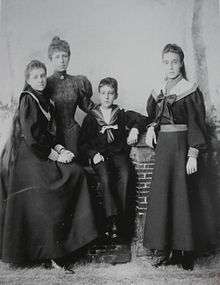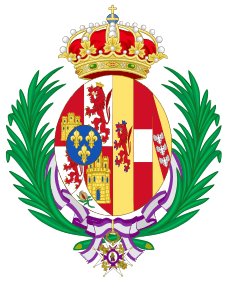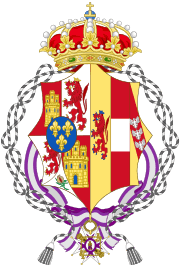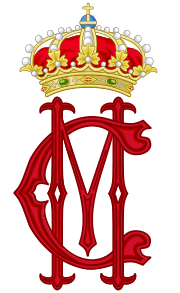Maria Christina of Austria
| Maria Christina of Austria | |||||
|---|---|---|---|---|---|
 | |||||
| Queen consort of Spain | |||||
| Tenure | 29 November 1879 – 25 November 1885 | ||||
| Born |
21 July 1858 Brünn (now Brno), Moravia, Austria | ||||
| Died |
6 February 1929 (aged 70) Palacio Real, Madrid, Spain | ||||
| Burial | El Escorial | ||||
| Spouse | Alfonso XII, King of Spain | ||||
| Issue | |||||
| |||||
| House | Habsburg-Lorraine | ||||
| Father | Archduke Karl Ferdinand of Austria | ||||
| Mother | Archduchess Elisabeth Franziska of Austria | ||||
| Religion | Roman Catholicism | ||||
Maria Christina Henriette Desideria Felicitas Raineria of Austria,[1] also known as Maria Christina Henrietta Désirée Félicité Rénière[2] (21 July 1858 – 6 February 1929) was Queen of Spain as the second wife of King Alfonso XII. She was regent during the vacancy of the throne between her husband's death and her son's birth, and during the minority of their son, Alfonso XIII, between 1885 and 1902.
Early life
Known to her family as Christa, she was born at Židlochovice Castle (Groß Seelowitz), near Brünn (now Brno), in Moravia, a daughter of Archduke Karl Ferdinand of Austria and his wife, Archduchess Elisabeth Franziska of Austria.[2]
Her paternal grandparents were Archduke Charles of Austria and Princess Henriette Alexandrine of Nassau-Weilburg.
Various sources attributed good traits to Maria Christina before her marriage. One states she was "tall, fair, sensible, and well educated".[3] She was Princess-Abbess of the Theresian Royal and Imperial Ladies Chapter of the Castle of Prague (1875-1879).[4]
Marriage and issue

Maria Christina married King Alfonso XII of Spain on 29 November 1879 at the Basilica of Atocha in Madrid, and became the mother of his only three legitimate children:
- Infanta María de las Mercedes of Spain; married Prince Carlos of Bourbon-Two Sicilies
- Infanta María Teresa of Spain; married Prince Ferdinand of Bavaria
- Alfonso XIII of Spain (born after his father's death); married Princess Victoria Eugenie of Battenberg
His previous wife was Mercedes of Orléans, who had died half a year after their marriage, leaving no issue. She lived a discreet life as queen.
Regency
When the King died, Maria Christina was pregnant, so the throne was vacant, depending on whether Maria Christina's unborn child was a male or a female; a male would make that child king, while a female would place her elder daughter, Infanta María Mercedes, on the throne. During this period, Maria Christina ruled as regent until her child, a son, was born, who was Alfonso XIII of Spain from birth. Maria Christina continued as regent until Alfonso XIII attained his majority in 1902; she is the "Her Majesty the Queen Regent of Spain" named as concluding the Treaty of Paris (1898) with the United States of America, ending the Spanish–American War.
Her chief adviser and head of government was Práxedes Mateo Sagasta. Her rule is described as well-balanced and in accordance with respect for constitutional rights, and many political reforms were instated during her regency to prevent political conflicts and chaos. Her role was mostly ceremonial, and her purpose was to preserve the crown for her son until he became an adult.
Later life
After her son's marriage in 1906, she lost her position as first lady at court. Nevertheless, Alfonso XIII continued to look to her on many occasions for advice.
She was the 805th Dame of the Royal Order of Queen Maria Luisa.
In February 1929, after some weeks of heart disease, she died at the Royal Palace in Madrid and is buried at El Escorial. Sir Charles Petrie, Alfonso XIII's biographer, maintained that the Queen dowager's death had a disastrous effect on her son, and that the latter never recovered politically from the blow. Within little more than two years the monarchy had collapsed.
Heraldry
| Heraldry of Maria Christina of Austria | ||||||
|---|---|---|---|---|---|---|
|
Ancestry
Bibliography
References
- ↑ "Maria Christina (Henriette Desideria Felicitas Raineria), Sternkreuzordens-Dame, Ehrengroßkreuz des souveränen Malteser-Ritterordens; geb. zu Groß-Seelowitz den 21. Juli 1858, vermählt zu Madrid den 29. November 1879 mit Seiner Majestät Alphons XII., König von Spanien, Inhaber des Infanterie-regiments Nr. 94, Witwe seit 25. November 1885." Schematismus für das kaiserliche und königliche Heer und für die kaiserliche und königliche Kriegsmarine für 1904. Vienna: Druck und Verlag der k.k. Hof- und Staatsdruckerei, December 1903. p.22
- 1 2

- ↑ Wormeley Latimer, p. 382.
- ↑ http://www.guide2womenleaders.com/czech_eccleastical.htm
| Wikimedia Commons has media related to Maria Christina of Austria. |
Sources
- Campos y Fernández de Sevilla, Francisco-Javier. María Cristina de Habsburgo y la Regencia, 1885–1902. San Lorenzo de El Escorial: Estudios Superiores del Escorial, Real Colegio Universitario "María Cristina", 1994.
- Cancio R. Capote, Rita Maria. The Function of Maria Christina of Austria's Regency, 1885–1902, in Preserving the Spanish Monarchy. México: Ediciones Botas, 1957.
- Figueroa y Torres, Alvaro de, Conde de Romanones. Doña María Cristina de Habsburgo Lorena, la discreta regente de España. Madrid: Espasa-Calpe, 1934.
- Martín Alonso, Aurelio. Diez y seis años de regencia, María Cristina de Hapsburgo-Lorena, 1885–1902. Barcelona: L. Tasso, 1914.
- Thoma, Helga. Habsburgs letzte Herrscherin: Maria Christine, Erzherzogin von Österreich, Königin-Regentin von Spanien. Wien-Klosterneuburg: Edition Va Bene, 2003.
- Wormeley Latimer, Elizabeth (1907). Spain in the Nineteenth Century. Chicago: A.C. McClurg & Co.
External links
- Newspaper clippings about Maria Christina of Austria in the 20th Century Press Archives of the German National Library of Economics (ZBW)
Maria Christina of Austria Born: 21 July 1858 Died: 6 February 1929 | ||
| Spanish royalty | ||
|---|---|---|
| Vacant Title last held by Mercedes of Orléans |
Queen consort of Spain 29 November 1879 – 25 November 1885 |
Vacant Title next held by Victoria Eugenie of Battenberg |


